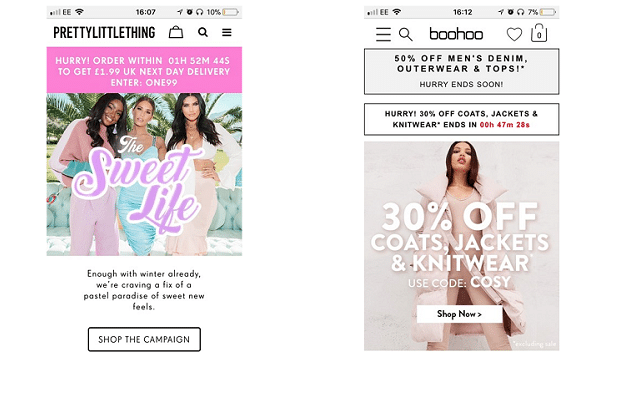
In 2016, UK retailers took £25 billion in sales over the Christmas period alone, nearly half of which were completed on a mobile device. User experience (UX) agency Sigma, evaluated the hidden strategies that some brands use on their websites to boost sales in a report on the topic last Christmas. They revisited the subject this year, looking at tactics used around Black Friday, Christmas and the January sales.
Amazon
One year on from demonstrating an array of questionable design strategies – such as encouraging users to sign up to its Amazon Prime service, without clearly stipulating that the free trial would roll into a monthly payment – Amazon has been singled out once again for underhandedly attempting to upsell insurance products, by the same method.
Having clicked to buy an electrical item, instead of clicking straight through to either the basket or the checkout pages, the site displays a pop-up for breakdown cover, drawing the shopper’s attention towards a yellow “Add to basket” button and away from a greyed out “No thanks” button. Given that we are drawn towards visual elements which stand out from their surroundings, it’s clear that Amazon is aiming to trick the user into adding a – potentially unnecessary – extra purchase.

AO.com
Research also showed that major electrical retailer AO.com was offering discounts on sale items for shoppers to apply during the checkout process – but that these were later difficult to both find and redeem. Whilst incentivising purchase is not misconduct in itself, AO.com appears to have offered an extra promotion at this crucial stage in the process to tempt shoppers into buying items already on sale, but not clearly signposted such codes in the checkout process.
Clas Ohlson
Home store, Clas Ohlson, was found to be offering a hardware product on sale – with a bright red ‘clearance’ flash, suggesting that the item may only be available at a low price for a short time only. However, on closer inspection, the offer is actually valid until July 2018; more than six months later. It would seem that the brand is using Dark UX tactics to lure customers into a ‘panic’ purchase and consequently increase sales.
Very
Women’s fashion e-retailer Very was also found to be deploying complex UX during the checkout process to encourage users to sign up for both its own and third-party marketing materials. Two ‘opt in’ and ‘opt out’ checkboxes – both using vague and convoluted language – were clearly out to serve Very’s business goals, given that the syntax does not at all help the user in deciding whether to tick it.
Pretty Little Thing and Boohoo
The research revealed that both fashion e-commerce sites are capitalising on the ‘fear of missing out’ by urging customers to complete their purchases before a ‘limited’ delivery offer is no longer available. However, it is unclear whether the offer is genuinely limited, or simply a countdown to a regular, daily occurrence. Shoppers may once again be panicked into buying an item at that moment, instead of taking time to reflect on whether it is what they really want or need.
Etsy
Similarly, marketplace Etsy was also found to be using scare tactics to encourage shoppers to purchase through the illusion of limited stock and competition for a particular product. Underneath the ‘Add to Cart’ button, the store provides live ‘updates’ on the number of products still available. This is particularly provocative for a retailer of ‘handmade’ products, which are likely to be made in small quantities. However, the claim is completely unsubstantiated and may be used deliberately to accelerate purchase.
Commenting on the findings, Hilary Stephenson, managing director at Sigma, said: “Whilst we understand that the retail landscape is extremely competitive at the moment – particularly in an age where e-commerce sites can quite literally ‘pop up’ out of nowhere – it’s extremely concerning that big-name brands are using underhand tactics to try and squeeze more money, data or marketing channels out of consumers.
“We had hoped to see an improvement on the use of Dark UX patterns since completing a similar analysis last year. However, it seems that these unethical practices are still very much in place. The examples listed above are just a brief cross-section of what we know is happening across the board – not just in retail, but in the leisure, travel and third sectors, too.
“User experience strategies are supposed to do just that; guide users through a site in the easiest and most transparent way possible. UK retailers would do well to remind themselves of this in future.”
